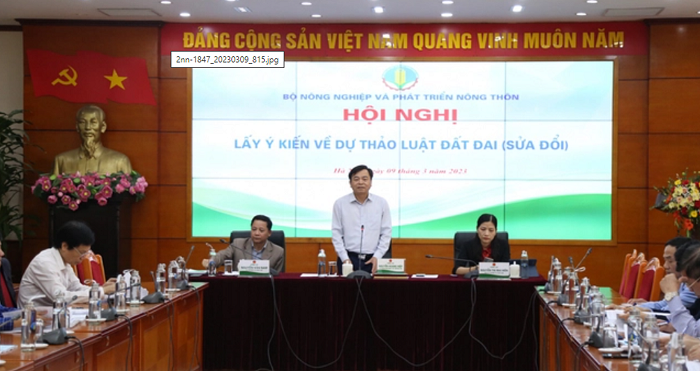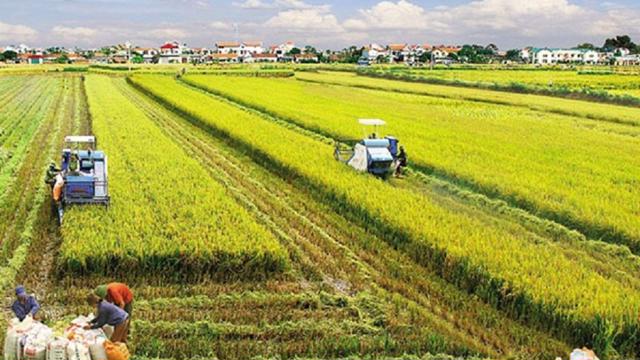[ad_1]
At a conference organized by the Ministry of Agriculture and Rural Development on the afternoon of March 9, 2013 to collect comments on the draft Land Law (amended), Deputy Minister of Agriculture and Rural Development Nguyen Hoang Hiep said that the Ministry of Agriculture and Rural Development Development set up a working group to review and comment on the revised draft of the Land Act.
The working group currently has 70 written comments. Many comments focused on the main groups of issues related to the agricultural sector: such as the future application of provincial law and sectoral law; the regime of management and use of rice land; including land accumulation, compensation …
SEVERAL IMPORTANCE ABOUT AGRICULTURAL LAND
Deputy Minister Nguyen Hoang Hiep would like to continue receiving comments on the revised draft Land Law, focusing on 5 issues: (i) Impact of the Land Law on 7 specialized laws in agriculture; (ii) How is the issue of agricultural land regulated in the revised Land Code? (iii) the issue of good use of land funds for science and technology; (iv) The issue of multipurpose land use; (v) Role of the Department of Agriculture and Rural Development in the management of agricultural land.

According to a representative of the Vietnamese Association of Agricultural Economics and Rural Development, in recent years, land policies and laws still have limitations and shortcomings; The quality of land use planning and plans is not high, synchronization, overall, systematic, lack of long-term vision.
Land reclamation, compensation, support and resettlement have not yet ensured a balance of interests in some places; the market for land use rights has not yet developed stably; Land financing and land prices are still insufficient, leading to difficulties in practical implementation. Land resources were not exhausted, fully and sustainably promoted.
Small-scale agricultural production, fragmented and scattered land is still a major obstacle to agricultural economic development. Complaints, complaints, violations of the law on agricultural land are numerous, but the processing is still limited. Land accumulation is slow; fragmented land, low profit for agricultural production.
“There should be regulations on the type of land for agricultural processing plants, since processing plants cannot be located in residential areas and cannot be located in industrial production zones such as cement, iron and steel…”
Mr. Tran Manh Bao, General Manager of Thai Binh Seed Joint Stock Company.
In order to use the resources of agriculture, forestry and fisheries more effectively, a representative of the Association of Agricultural Economics and Rural Development said that the land law had to be adjusted (amended), agricultural land had to be “released”.
Mr. Tran Manh Bao, chairman and general manager of Thai Binh Seed Joint Stock Company (ThaiBinh Seed), said the revised land law must include regulations to preserve the rice land area, even if the crop structure is changed, the land can always be used if necessary grow rice.
“Drought is the most urgent problem in agricultural production, so a mechanism to accumulate land with a large area is needed for enterprises to ensure production efficiency. In addition, the land lease period for companies must be as long as in business contracts, avoiding the regulation of a free lease period, Mr. Bao said.
NEED POLICIES TO ENCOURAGE AGRICULTURAL ACCUMULATION OF LAND
associate Prof. Dr. Dao The Anh, deputy director of the Vietnam Academy of Agricultural Sciences, addressed the issue: The Vietnam Academy of Agricultural Sciences is a public, non-business entity that manages a large area of land. However, under current regulations, public science and technology organizations in the agricultural sector are not permitted to use the value of land use rights to contribute capital to joint ventures, associations and the implementation of investment projects. This leads to waste and pressure to protect and retain land for the managed entity.
“The draft Land Law (amended) only provides that fully autonomous entities may lease land. Therefore, the units are allowed to be partially autonomous, also to lease land,” said Mr. Dao The Anh.
“Currently, the Ministry of Agriculture and Rural Development manages 500 housing and land facilities in 20 administrative departments and 74 non-business units in 52 provinces/cities. Units under the Ministry of Agriculture and Rural Development manage and use about 253,807.2 hectares of land, of which 11 research institutes of the Ministry of Agriculture and Rural Development manage and use about 14,705 hectares of land.
According to the Ministry of Agriculture and Rural Development.
The same interest in this topic is shared by Dr. Ha Cong Tuan, former Deputy Minister of Agriculture and Rural Development, said that agricultural and forestry companies manage and use land that comes from agricultural and forestry companies. If the land has been granted a certificate of use to agricultural and forestry enterprises, these enterprises have fully established the legal status of land user and the right to self-government in production and economy in accordance with the provisions of the Act on Enterprises.
Therefore dr. Tuan suggested that there should be clear regulations to ensure that agroforestry companies that are allocated or leased land have the same rights as other companies in the self-organized production and economy and take responsibility to the state for their own land, which Effectively manage land and use allotted land.
Dr. Tuan addressed the current practical problem, most of the community land fund development organizations work with difficulty and mainly carry out the task of site clearance at the request of the community by creating a land fund for development according to master plans and plans due to problems in the operating mechanism, especially in the financial mechanism. In order to “solve” this problem, it is necessary to create a kind of agricultural land-use rights bank in order to promote the process of land accumulation and concentration and promote the formation of a healthy land-use rights market.
dr Tran Cong Thang, director of the Institute of Policy and Strategy for Agriculture and Rural Development, said there should be guidelines to encourage agricultural land accumulation to help enterprises build their own resource areas, but the level of encouragement should vary it will be limited, not as high as the concentrated form. Taxes and fees associated with the transfer of agricultural common land, such as other real estate, are currently relatively high compared to the profits that can be made from agricultural production. Proposal to reduce taxes and fees related to the transfer of agricultural land.
Land use conversion within the agricultural sector should be flexible; including rice land. In addition, it is necessary to regulate by law the restructuring of crops that are grown on non-natural production forest areas.
“It is necessary to develop a mechanism for land leased for 5 years or more, then individuals and organizations renting the land can mortgage the land at rental value to borrow capital for agricultural production. Also, companies that lease land with annual payments have difficulty mobilizing capital from the land. Therefore, it is recommended to increase the payment cycle from annually to 5-10 years/once and allow companies to pledge land use rights to borrow money from banks,” said Mr. Tran Cong Thang.
[ad_2]
Source link

